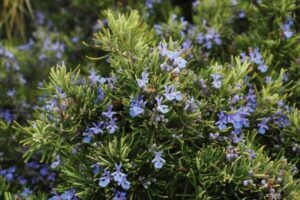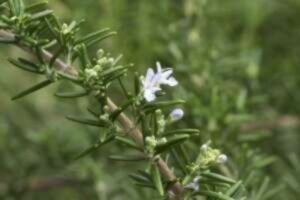Table of Contents
 Rosemary has long captivated gardeners, chefs, and herbal enthusiasts with its enchanting fragrance and versatile uses. As a perennial herb, it is a timeless addition to any garden, offering ornamental beauty and a wealth of culinary and medicinal benefits.
Rosemary has long captivated gardeners, chefs, and herbal enthusiasts with its enchanting fragrance and versatile uses. As a perennial herb, it is a timeless addition to any garden, offering ornamental beauty and a wealth of culinary and medicinal benefits.
This comprehensive guide will explore the fascinating world of rosemary, uncovering its perennial nature and imparting valuable insights on cultivating and caring for this remarkable herb.
From its historical significance to its culinary and medicinal applications, we will delve into the rich tapestry of rosemary’s past, present, and future. Whether you’re an experienced gardener seeking to expand your perennial collection or a beginner eager to embark on your herb-growing journey, this blog post will equip you with the knowledge and expertise needed to nurture thriving rosemary plants year after year.
Investigating the perennial nature of rosemary? Check out our article on Perennial Ryegrass vs. Tall Fescue to explore the differences between these two popular grass types.

So, let’s roll up our sleeves, dig into the soil, and unlock the secrets of growing and cherishing the beloved perennial herb – rosemary!
The lawn is precious for every green lover. They spend most of their time producing more fresh green. For this, you need to know the fertilization schedule. Overseeding and over-dose fertilization are unhealthy for your plants. So stay tuned and learn more.
Is Rosemary a Perennial? – That Works For All

Rosemary is known for its distinctive, strongly scented foliage. It is a member of the Mint family. Unlike other plants that turn into bare spots, it’s an evergreen shrub that doesn’t lose leaves in the off-season. Rosemary thrives in sandy soil, and full sun blooms profusely when happy and healthy. Growing rosemary as a perennial is simple with the right type of environment, good drainage, and proper care.
What is a perennial plant?

A perennial plant is a plant that lives for more than two years, reproducing by seed. The life span of some perennials can reach hundreds of years.
Perennial plants come from herbaceous plants, shrubs, and trees. These plants have a life cycle that lasts longer than two years. They can grow all year round because they store energy in their stems, roots, or leaves.
Perennial plants have several advantages over annuals:
- They require less maintenance.
- They are easier to maintain and do not need replanting every year.
- They are more resistant to pests and diseases because they have a stronger root system which allows them to fight off any threats to their survival.
How To Prove That Rosemary Is A Perennial Plant?
Rosemary (Rosmarinus officinalis) can be proven to be a perennial plant through several botanical characteristics and observations:
- Lifespan: Perennial plants live for more than two years, and rosemary fits this criterion as it can survive and thrive for many years, even decades, under the right conditions.
- Recurring Growth: Rosemary exhibits recurring growth, producing new foliage, flowers, and seeds throughout its life cycle. It only completes its entire life cycle, like annual plants, within a single growing season.
- Root System: Perennials typically have well-developed root systems that allow them to persist over multiple years. Rosemary forms a strong root system that aids in its survival and ability to regrow after winter dormancy.
- Survival through Seasons: Unlike annuals that die off at the end of the growing season or biennials that complete their life cycle in two years, rosemary can withstand different seasons and environmental conditions, resurfacing in the following spring after winter dormancy.
- Cold Hardiness: Rosemary demonstrates cold hardiness in temperate climates, where it can survive frost and freezing temperatures, resprouting in the spring from its woody stems or roots.
- Propagation Methods: Perennial plants like rosemary can be propagated through cuttings or division, allowing the plant to be perpetuated for many years.
Curious about the appearance of a ginger plant? Learn more with our article on ‘What Does a Ginger Plant Look Like?

Rosemary As a Shrub
Rosemary (Rosmarinus officinalis), a woody perennial herb, is often classified as a shrub due to its growth habit. In its natural Mediterranean habitat, it can reach 4 to 6 feet in height, but when cultivated in temperate regions or containers, it typically stays smaller, around 2 to 3 feet tall. With evergreen, needle-like leaves that emit a delightful fragrance when touched, rosemary makes an attractive and aromatic addition to gardens and landscapes. Its ornamental value, culinary uses, and medicinal properties make it popular. Besides, as a shrub, it offers habitat and food for wildlife, enhancing biodiversity in the garden. Versatile, enduring, and visually appealing, rosemary stands as a beloved perennial shrub for both herb enthusiasts and gardeners alike.
Which Zone is Best To Grow Rosemary?
Rosemary (Rosmarinus officinalis) is a versatile herb that can be grown in a wide range of climates, but it thrives best in regions with a Mediterranean-type climate. In general, it prefers warm, sunny, and well-draining locations. Let’s explore how rosemary fares in different zones around the globe:
- Hardiness Zones 7-10: Rosemary flourishes in these zones, which include Mediterranean-like climates and regions with mild winters and hot, dry summers. These zones are ideal for rosemary growth, and the plant can be considered a perennial here, thriving year after year with minimal winter protection.
- Hardiness Zones 5-6: In these zones, rosemary can still be grown as a perennial, but it may require some winter protection, such as mulching or covering during extreme cold spells.
- Hardiness Zones 1-4 and 11+: Rosemary can be grown annually in zones 1-4, where winter temperatures are extremely cold, and the plant cannot survive freezing conditions. In zones 11 and above, which have tropical or subtropical climates, rosemary can also be grown year-round, though it may require some shade and protection from intense heat.
- Container Gardening: Rosemary can be grown in containers for regions with colder climates or unsuitable soil conditions. This allows for easy mobility, so the plant can be brought indoors during winter or extreme weather conditions, extending its lifespan and making it accessible to a broader range of zones.
This is not necessary that rosemary can grow in only a specified Zone. Still, even in the optimal zones, it’s essential to provide proper care, well-draining soil, and adequate sunlight to ensure the healthy growth of rosemary. Additionally, microclimates within each zone can affect rosemary’s success, so local factors should always be considered when cultivating this delightful herb.
Which Season is Best to Plant Rosemary?

The best season to plant rosemary depends on the climate and region you are in. Generally, rosemary is best planted in the spring or fall, as these seasons provide favorable conditions for the plant’s establishment and growth.
- Spring: Planting rosemary in the spring allows the herb to take advantage of the warming temperatures and longer daylight hours. The soil is also warming up, which promotes root development and encourages the plant to establish itself quickly. By planting in the spring, rosemary has ample time to grow and strengthen before winter arrives.
- Fall: Fall is another excellent time to plant rosemary, especially in regions with mild winters. By planting in the fall, the herb can take advantage of the cooler temperatures to establish its root system without the stress of hot summer conditions. This gives the plant a head start the following spring, promoting healthy growth and better resilience during the hot summer.
On the other hand, winter and summer are generally less favorable for planting rosemary:
- Winter: Planting in the winter is not recommended, especially in colder climates. Rosemary prefers warmer conditions and may struggle to establish its root system during the cold months. The herb may not survive the harsh winter temperatures if newly planted in freezing regions.
- Summer: Planting rosemary in the summer can be challenging due to the high temperatures and potential drought conditions. Transplant shock can be more significant during hot weather, and the plant may require frequent watering and extra care to survive and establish itself.
Rosemary Planting Instructions
Planting rosemary is a straightforward process, but to ensure the best chance of success, it’s essential to follow these instructions:
- Select a Suitable Location: Choose a sunny spot for your rosemary plant, as it requires at least 6-8 hours of direct sunlight daily. The soil should be well-draining to prevent soggy roots, as rosemary dislikes excessive moisture.
- Prepare the Soil: Rosemary thrives in slightly alkaline soil with a pH between 6.0 and 7.5. Consider adding some lime to raise the pH if your soil is acidic. Incorporate organic matter like compost to improve soil structure and fertility.
- Choose the Plant: You can start rosemary from seeds, but purchasing young plants from a nursery or garden center is often easier. Look for healthy plants with no signs of pests or disease.
- Planting Time: As mentioned earlier, the best time to plant rosemary is in the spring or fall when temperatures are moderate.
- Dig the Hole: Dig a hole in the prepared soil slightly larger than your rosemary plant’s root ball.
- Planting Depth: Place the rosemary plant in the hole, ensuring the top of the root ball is level with the surrounding soil surface.
- Backfill and Water: Fill the hole with soil, gently pressing it down to remove any air pockets. Water thoroughly after planting to settle the soil around the roots.
- Mulch: Apply a layer of mulch around the base of the plant to retain moisture, suppress weeds, and regulate soil temperature.
- Watering: While rosemary is relatively drought-tolerant, keeping it adequately watered during the first growing season is essential to establish a strong root system. Once established, water sparingly, allowing the soil to dry slightly between waterings.
- Pruning: Regular pruning promotes bushier growth and maintains the plant’s shape. Prune after flowering or during the spring to remove any dead or woody growth.
- Winter Care: In colder climates, protect your rosemary from frost by bringing potted plants indoors or providing a layer of mulch around the base.
Also Read: How Much Water Do Snake Plants Need?
Health Benefits Of Rosemary
Rosemary (Rosmarinus officinalis) not only adds a delightful flavor to various dishes but also boasts a range of health benefits. This aromatic herb has been used for centuries in traditional medicine for its medicinal properties. Here are some of the notable health benefits of rosemary:
- Rich in Antioxidants: Rosemary is packed with antioxidants, such as rosmarinic acid and carnosic acid, which help neutralize harmful free radicals in the body. These antioxidants can protect cells from oxidative stress and reduce the risk of chronic diseases.
- Anti-Inflammatory Properties: Rosemary contains anti-inflammatory compounds that can help reduce inflammation. This may be beneficial for managing inflammatory conditions like arthritis and improving overall joint health.
- Enhances Cognitive Function: Some studies suggest that rosemary may improve cognitive function and memory. Inhaling the aroma of rosemary essential oil or incorporating it into the diet has been linked to enhanced focus and mental clarity.
- Digestive Aid: Rosemary can aid digestion by stimulating the release of digestive enzymes. It may help alleviate indigestion, bloating, and stomach cramps.
- Immune System Support: The antioxidants in rosemary, combined with its anti-inflammatory effects, may bolster the immune system and help the body fight infections and illnesses.
- Respiratory Health: Rosemary’s essential oil has expectorant properties to help ease respiratory congestion and promote better breathing.
- Hair and Scalp Health: Rosemary-infused oils or shampoos stimulate hair follicles, promoting growth and reducing dandruff.
- Skin Benefits: Rosemary’s antimicrobial and anti-inflammatory properties benefit skin health. It may help soothe irritated skin, reduce acne, and support overall wellness.
- Blood Circulation: Rosemary has been traditionally used to improve blood circulation, which may support cardiovascular health and reduce the risk of related conditions.
- Stress Relief: The aroma of rosemary has calming effects and can help reduce stress and anxiety levels. Its essential oil is often used in aromatherapy for relaxation.
Final Words To Conclude Rosemary A Perennial Plant
Rosemary is a perennial plant that can grow up to three feet. It will come back year after year. Some varieties of rosemary can live for more than 20 years. It has grey-green leaves with needle-like tips. It is used as an ornamental plant in many areas of the world.
One way to help your rosemary grow well in pots is by repotting it every year or two. This allows it to develop new roots and establish itself in a larger pool.
Rosemary can be grown as an annual or perennial herb. If you want to grow rosemary as a perennial, it must be planted in a container that drains well and kept indoors until temperatures are warm enough for planting outside.
Rosemary plants require good drainage and prefer full sun but can tolerate partial shade. They’ll grow well in sandy soil, but they do best if some compost is mixed into their soil. Rosemary grows best in temperatures between 65°F and 75°F (18°C – 24°C).
Rosemary can be propagated by planting cuttings or seeds or dividing established plants. The easiest way to start growing your rosemary plants is by purchasing them at your local nursery or garden center during their spring or fall sale periods when they offer discounted prices on plants.
